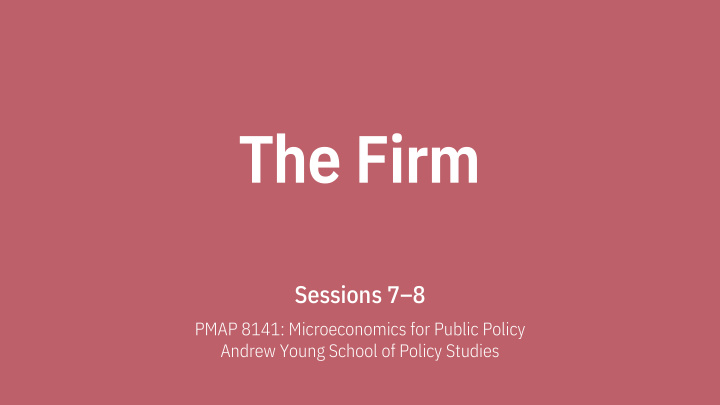



The The Fir Firm Sessions 7–8 PMAP 8141: Microeconomics for Public Policy Andrew Young School of Policy Studies
Plan for today Income and substitution effects Firms Asymmetric information Owners, managers, and employees
Income and substitution effects
Why do we even care about indifference curves? Indifference curve meeting budget line = where happiness meets reality Policies change individual budget lines and move people to different indifference curves
Normal goods As income increases, you buy more Inferior goods As income increases, you buy less
Income effect How much more/less of X you consume because you’re richer/poorer Movement to a new indifference curve because of a change in income or feasibility Substitution effect How much more/less of X you consume because you trade off with Y Movement along the same indifference curve because of a change in the mix of inputs
Firms
What do firms do? Provide legal shielding for owners Employ people Purchase inputs to provide goods and services Set prices higher than cost of production
How are decisions made? In markets In firms Choices emerge with no Decisions are centralized planning centrally planned "If a workman moves from department "[The market] is in fact a very Eden of the innate rights of man. Y to department X, he does not go There alone rule Freedom, because of a change in prices but Equality, Property." because he is ordered to do so." Karl Marx, Capital , chapter 6 Ronald Coase, “The Nature of the Firm”
Consequences of authority “The directing motive, the end and aim of capitalist production, is to extract the greatest possible amount of surplus-value, and consequently to exploit labour-power to the greatest possible extent.” Karl Marx, Capital , chapter 13
Consequences of authority Costs of transacting in a market lead to the natural emergence of firms to deal with them. Firms make markets more efficient.
“The firm in a capitalist economy is a miniature, privately owned, centrally planned economy.” ESPP 6.2 “…islands of conscious power in this ocean of unconscious cooperation” D. H. Robertson, The Control of Industry
Organizational structures Ownership? Strategy? Implementation? Nonprofits? Governments?
Organizational structures Proposal power Enforcement power Centralize Implementation power Decentralize
Asymmetric information
Asymmetric information Adverse selection Hidden knowledge Lemons Insurance Death spirals Moral hazard Hidden action Crime prevention Reaching exact incentives Repairs
Asymmetric information Adverse selection Fix with screening I’m going skydiving next week so I’ll get insurance Moral hazard Fix with monitoring I have insurance so I’ll take up skydiving
Explanations go both ways
Owners, managers, and employees
Principal-agent problems Principal gives an agent (1) authority, (2) autonomy, and (3) discretion to do something for them Principal lacks information to make sure agent does it Agent’s preferences don’t always align with principal’s
Action that is hidden Principal Agent and not covered in the contract Employer Employee Quality and quantity of work Banker Borrower Repayment of loan, prudent conduct Owner Manager Maximization of owners’ profits Landlord Tenant Care of the apartment Insurance company Insured Prudent behavior Parents Teacher/doctor Quality of teaching and care Parents Children Care in old age
Conflicts of interest Benefit from profits No direct benefit from profits
Conflicts of interest Need to ensure high quality effort Not constantly monitored
How do you align everyone’s interests? Contracts! A legal document or understanding that specifies a set of actions that parties to the contract must undertake Temporary, limited transfer of authority in labor markets
Incomplete contracts Contracts are inherently incomplete Relationships are inherently asymmetric Tasks based on unknown future Tasks difficult to measure Piece rate pay for MPA/MPP jobs?
But workers still work! Why? Norms Feelings of responsibility Calling Public service motivation For economists: fear of being fired
Employers can’t directly monitor employees Keep employees working by increasing the cost of job loss Large employment rent → large cost of job loss → worker works more to avoid getting fired
Economic rents Benefits of job − Costs of job = Employment rent
Economic rents
The labor discipline game Employer chooses a wage If worker works hard enough, they keep job at that wage Worker chooses level of effort Worker considers costs of losing job if they don’t work hard enough Payoffs Firm: profit = worker’s output − wage Worker: employment rent
Involuntary unemployment Necessary to keep employment rent high enough for workers to keep working 4.5–6%
Recommend
More recommend